Basal Ganglia and Cerebellum
1/49
There's no tags or description
Looks like no tags are added yet.
Name | Mastery | Learn | Test | Matching | Spaced |
|---|
No study sessions yet.
50 Terms
What is the role of basal ganglia?
1. Movement ON/OFF
2. Movement specificity
3. Learning
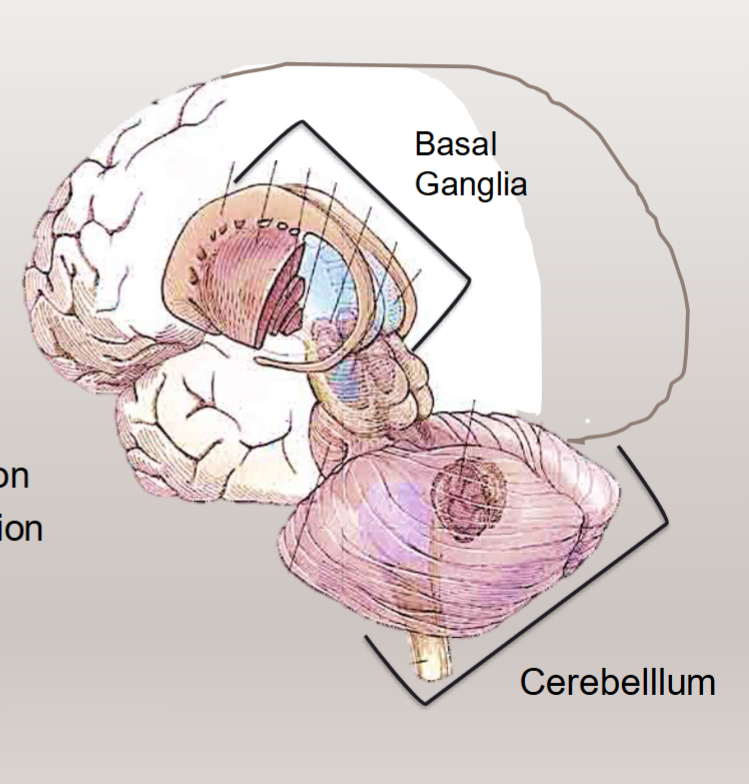
What is the role of the Cerebellum
1. Movement Error Detection
2. Movement Error Correction
3. Learning
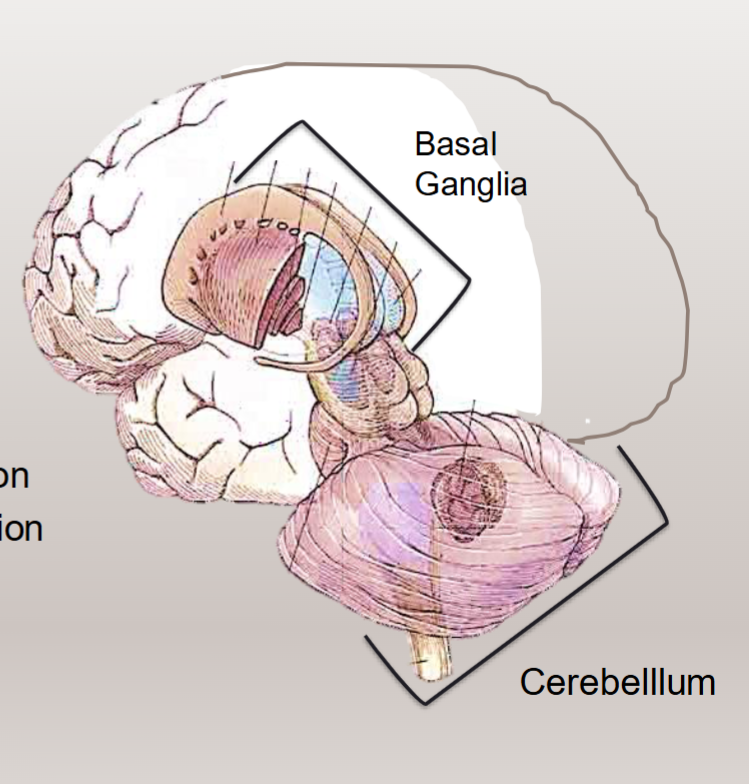
What are some characteristics of the Basal Ganglia and Cerebellar Circuits
• Receive input from cortex
• Provide output to upper motor neurons of the cortex
and brainstem
• Basal Ganglia and Cerebellar circuits are
predominantly inhibitory
• These circuits must be disinhibited to promote
movement
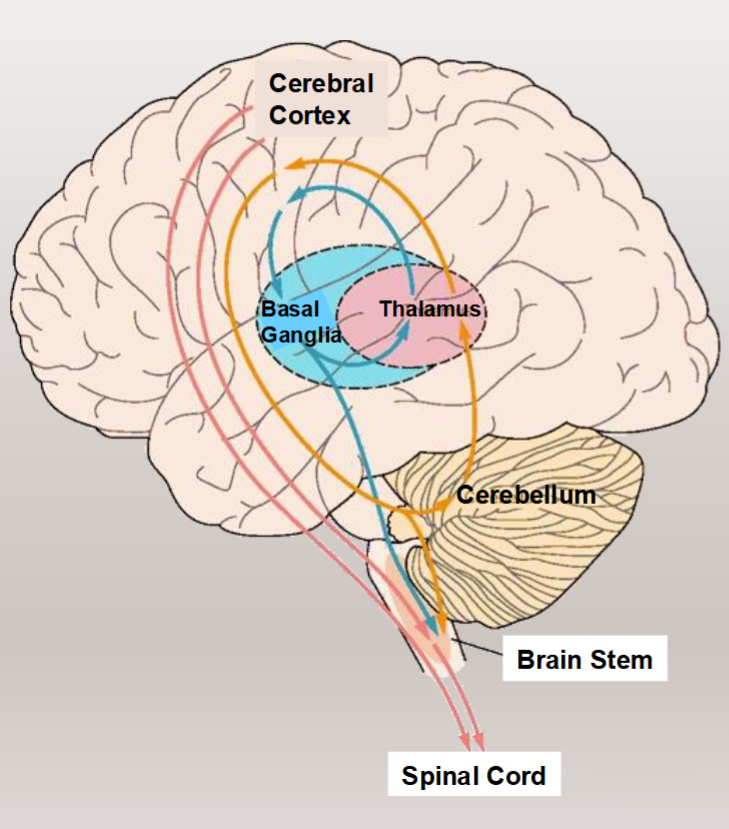
Basal Ganglia
• Required for ____ ____ ____
• Mediates ____ transitions between commands for _____ ____ and/or _____ ______
• These functions are disrupted by ___ ____ and ____ ____
Basal Ganglia
• Required for normal voluntary movement
• Mediates smooth transitions between commands for
movement initiation and/or movement termination
• These functions are disrupted by Parkinson’s Disease (PD) and Huntington’s Disease (HD)
Different Parts of Basal Ganglia
Corpus Striatum
Caudate
Putamen
Globus Pallidus
Subthalamic Neurons
Substantia Nigra
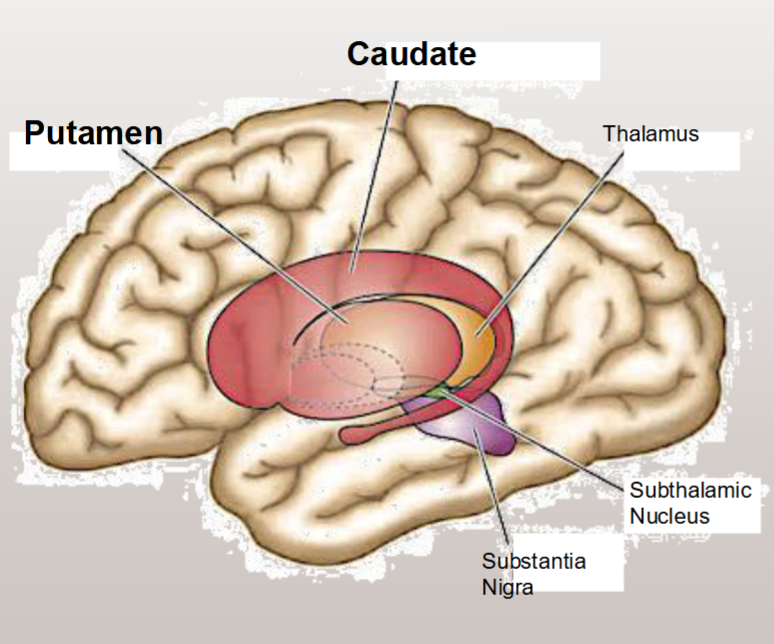
What is the role of the Corpus Striatum?
Input to the Basal Ganglia
Receives Cortical Input
Consists of Caudate and Putamen
Role: relay cortical information to basal ganglia circuit
Target of dopamine neurons from substantia nigra
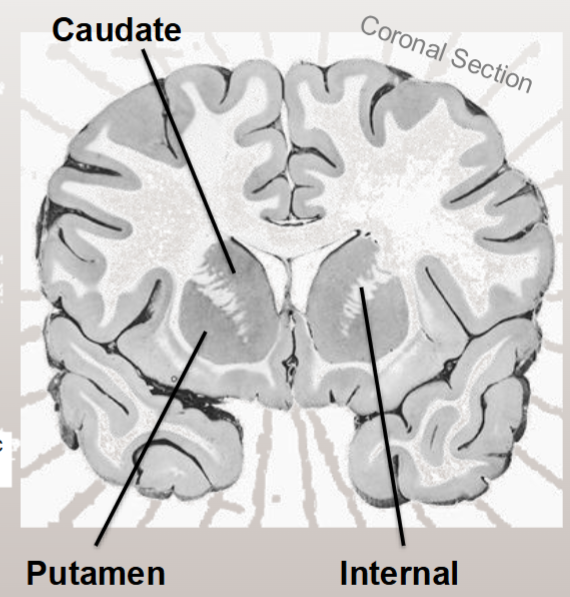
What is the internal capsule
Part of the corpus striatum that is white matter, and are axons from cortex
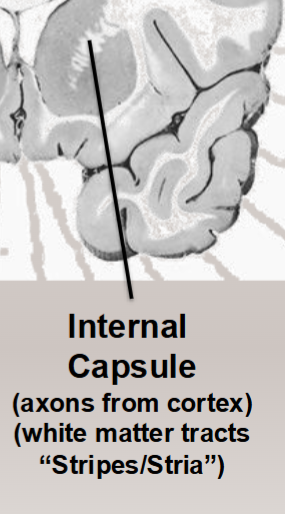
What is the role of the Caudate?
Caudate (eye/head movement and body movements)
Sensory input from cortex
Motor input from eye areas in frontal lobe and motor cortex
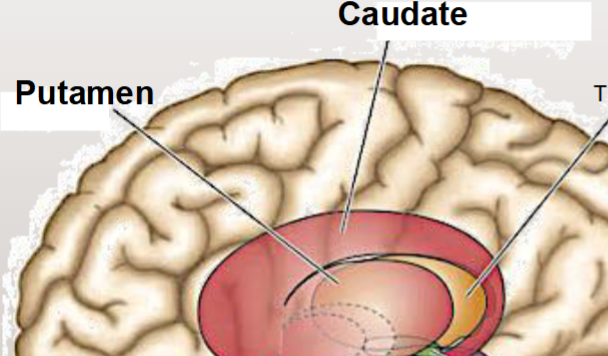
What is the role of the putamen?
Putamen (body movements)
Sensory input from cortex
Motor input from Premotor and Motor cortex
Topological map of body
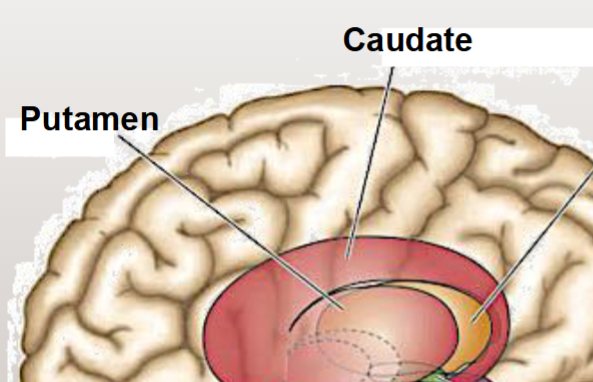
What is the role of the Globus Pallidus?
“where the inaction happens”
• Receives input from the corpus striatum
• Role: inhibit the thalamus
• Must be “turned off” for movement

What is the role of the thalamus?
Relays ___ output to ___ cortex
• Receives inhibition from the ___ ___ ____
• Role: Provide ____ drive to ___ cortex
• Must be ____ for movement
Relays BG output to motor cortex
• Receives inhibition from the internal globus pallidus (GPi)
• Role: Provide excitatory drive to motor cortex
• Must be disinhibited for movement (reduction of inhibitory influence on thalamic neurons)
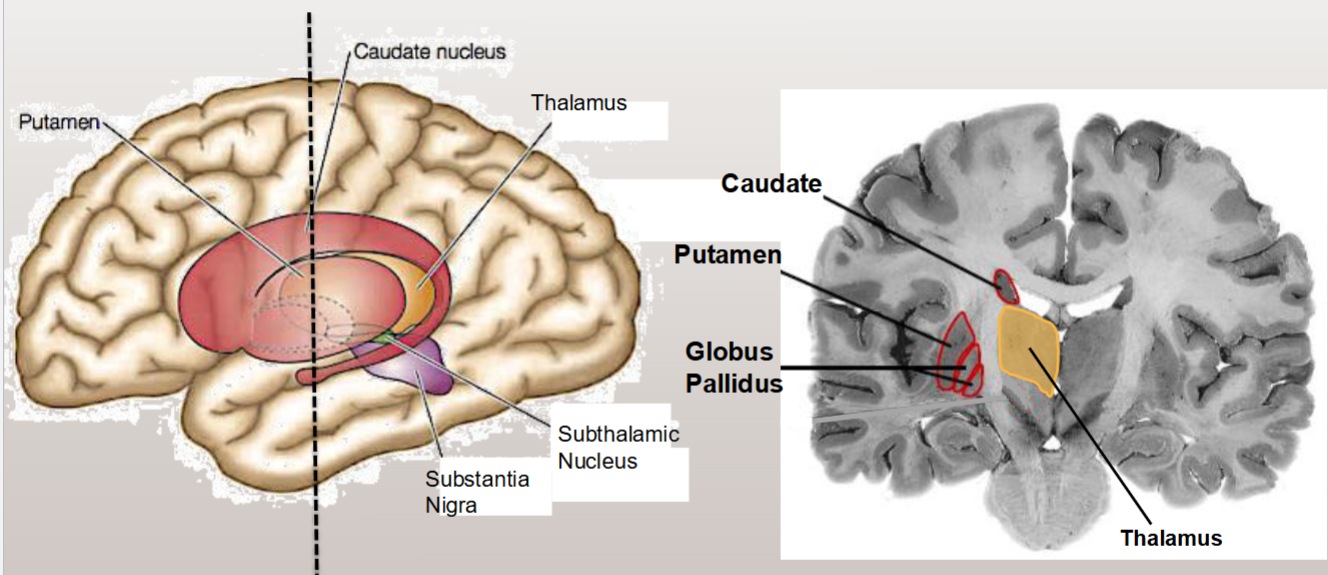
What is the Basic Loop: Direct Pathway through Basal Ganglia
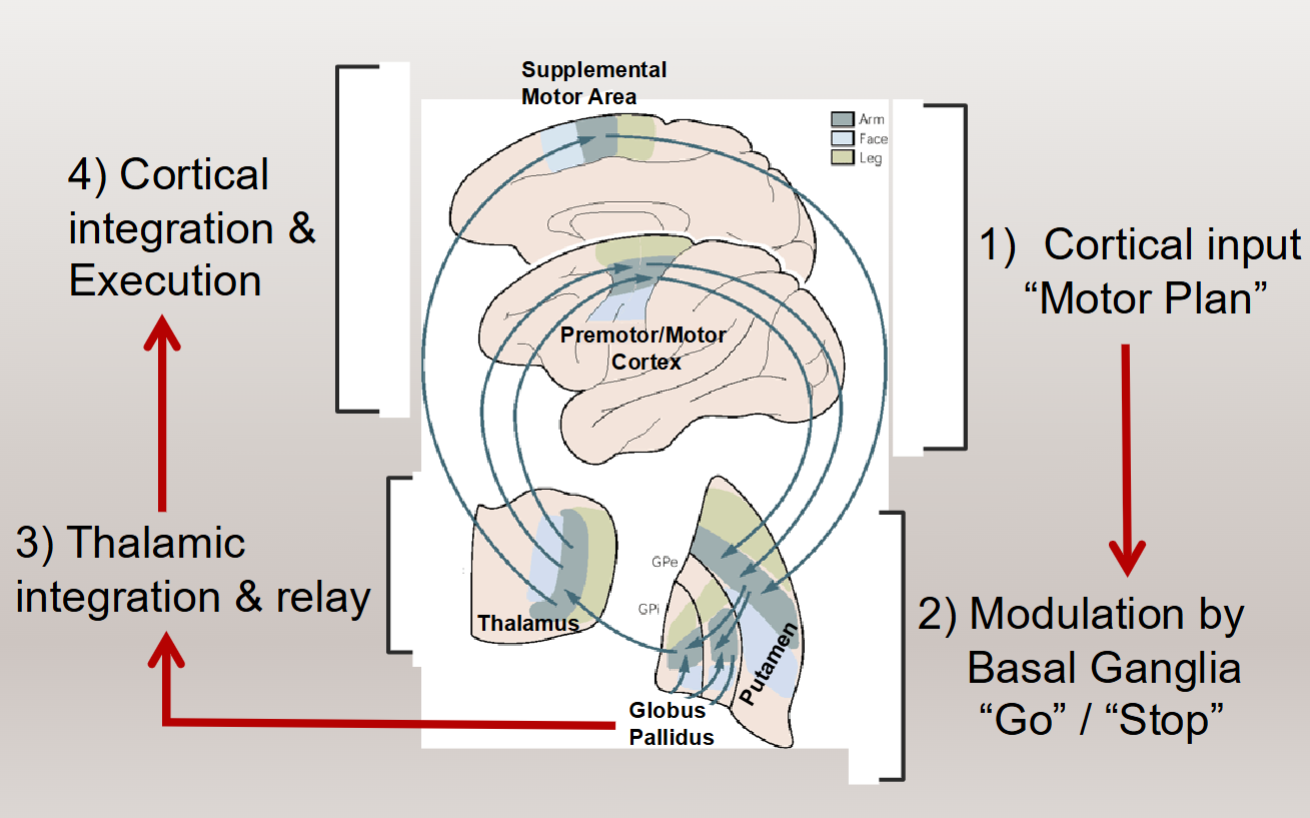
How can the Basal Ganglia Modulate the amount of inhibition sent to the thalamus?
Modulating GABA signaling to thalamus
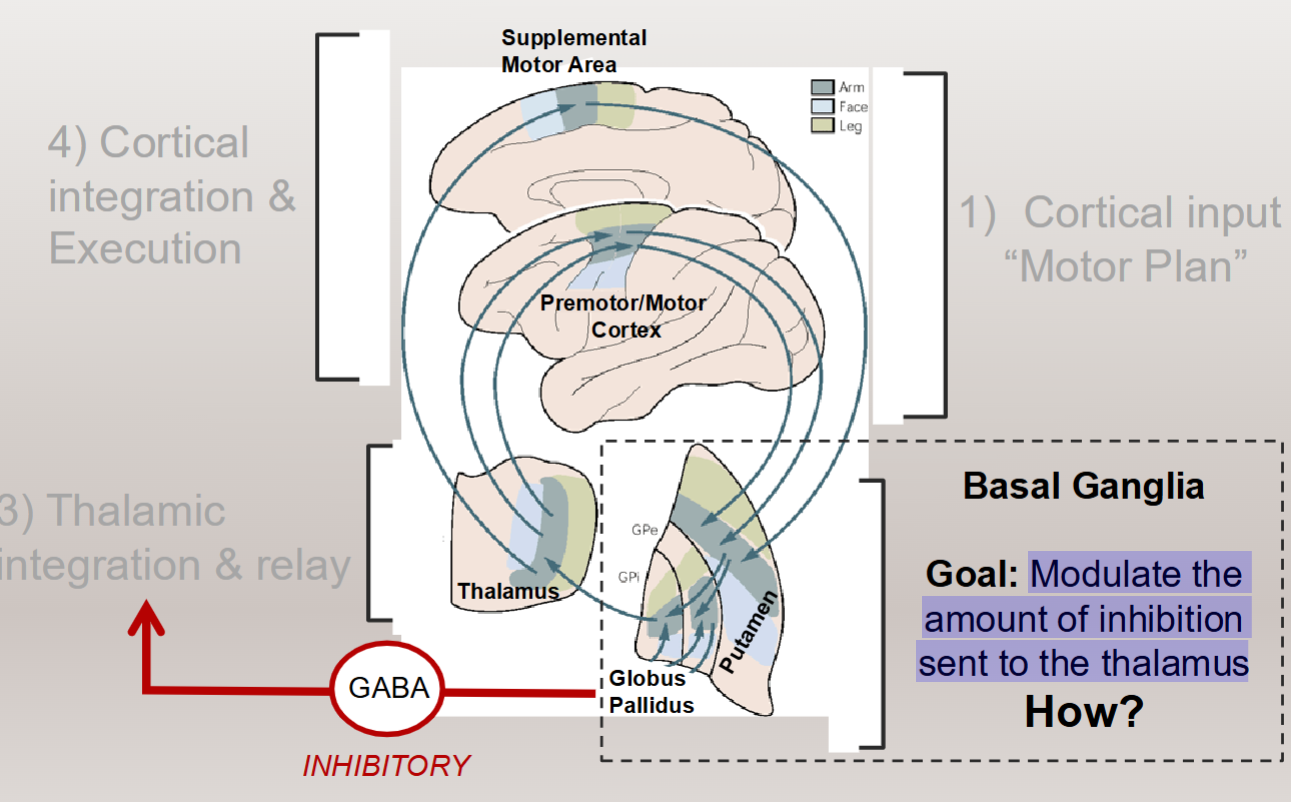
What are the broad characteristics of Basal Ganglia Neurons?
• The caudate and putamen are together called the ____ ____
• ____ ____ ____ in the caudate and putamen receive _____ input
•____ ______ Neurons
• Do not ___ ____ ____ easily, require ____ ____ ____.
• They fire action potentials ____ movement
• Code a ___ __ ___ ____ _ ____ rather than ____ itself.
• ____ neurons in the ___ ___ & ____ ____ ___ ____
• The caudate and putamen are together called the “Corpus Striatum”
• Medium spiny neurons in the caudate and
putamen receive cortical input
• GABAergic Inhibitory Neurons
• Do not fire action potentials easily, require
many cortical inputs
• They fire action potentials before movement
• Code a “decision to move toward a goal”
rather than movement itself.
• Inhibit neurons in the Globus Pallidus &
Substantia Nigra Pars Reticulata
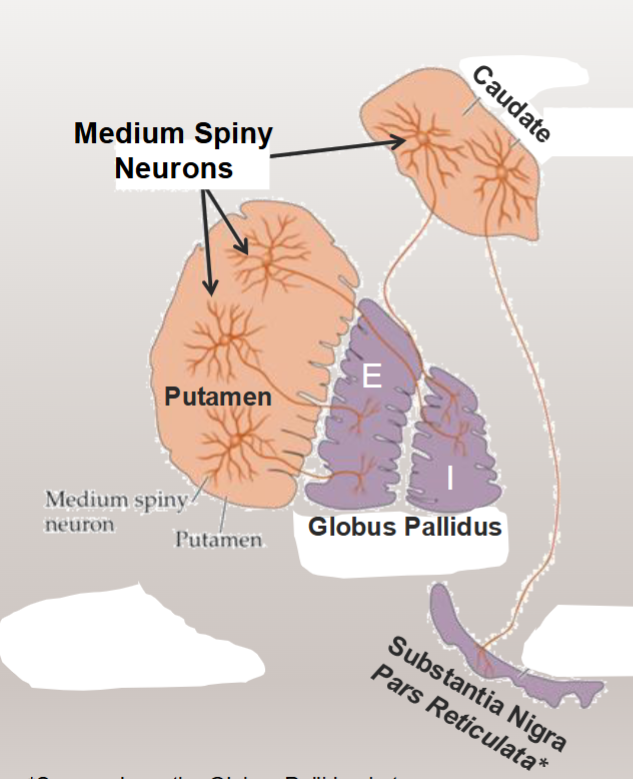
What does the Substantia Nigra Pars Reticulata do?
Same role as the Globus Pallidus but projects inhibition to the superior colliculus (upper motor neurons) to control eye and head movements
Projection from Corpus Striatum to Globus Pallidus
• A globus pallidus neuron receives input from ~ 100 ___ ___ ____ (MSNs)
• MSNs make a small number of synapses with many ___ ____ ____ (GPNs)
• Also make a ____ number of synapses with a ____ GPNs
• Required to ensure initiation of the ___ ___ ___
• MSNs release ___ and inhibit _____
• A globus pallidus neuron receives input from ~ 100 medium spiny neurons (MSNs)
• MSNs make a small number of synapses with many globus pallidus neurons (GPNs)
• Make a large number of synapses with a few GPNs
• Required to ensure initiation of the correct motor plan
• MSNs release GABA and inhibit GPNs
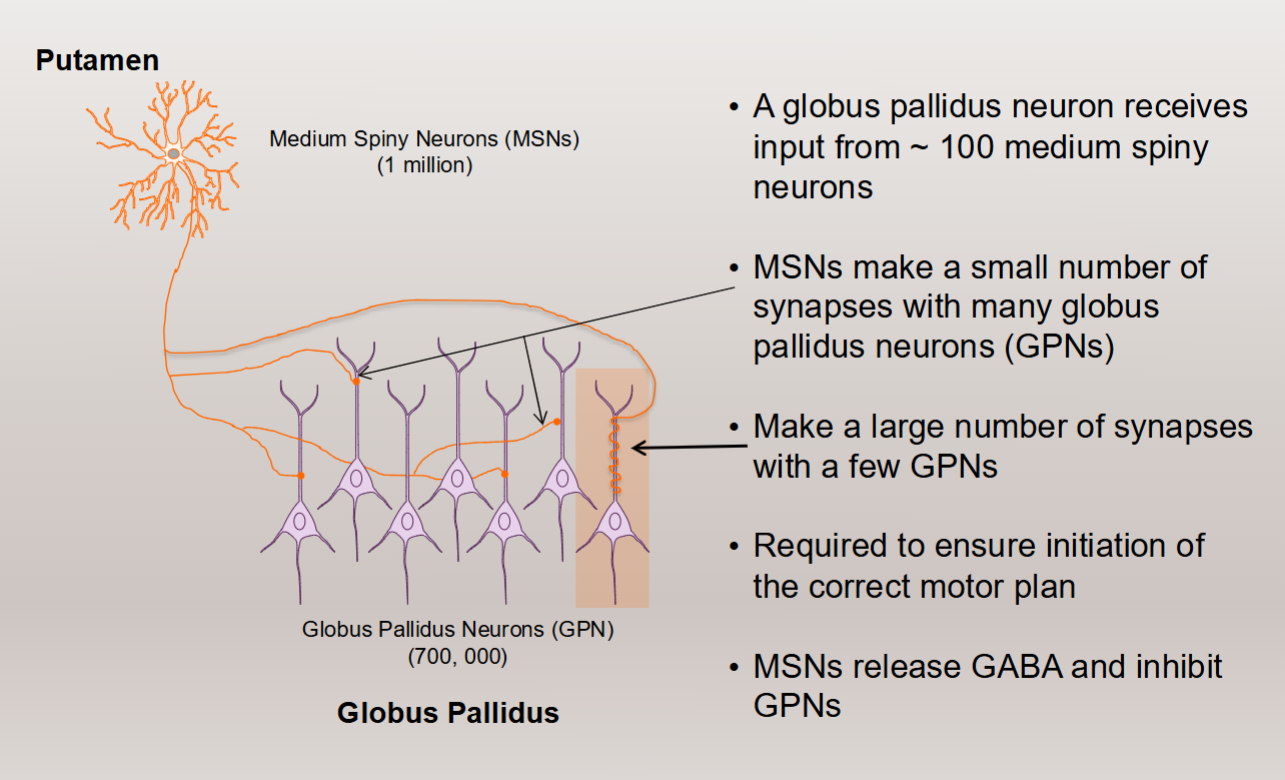
Basic Neural Circuit of the Basal Ganglia
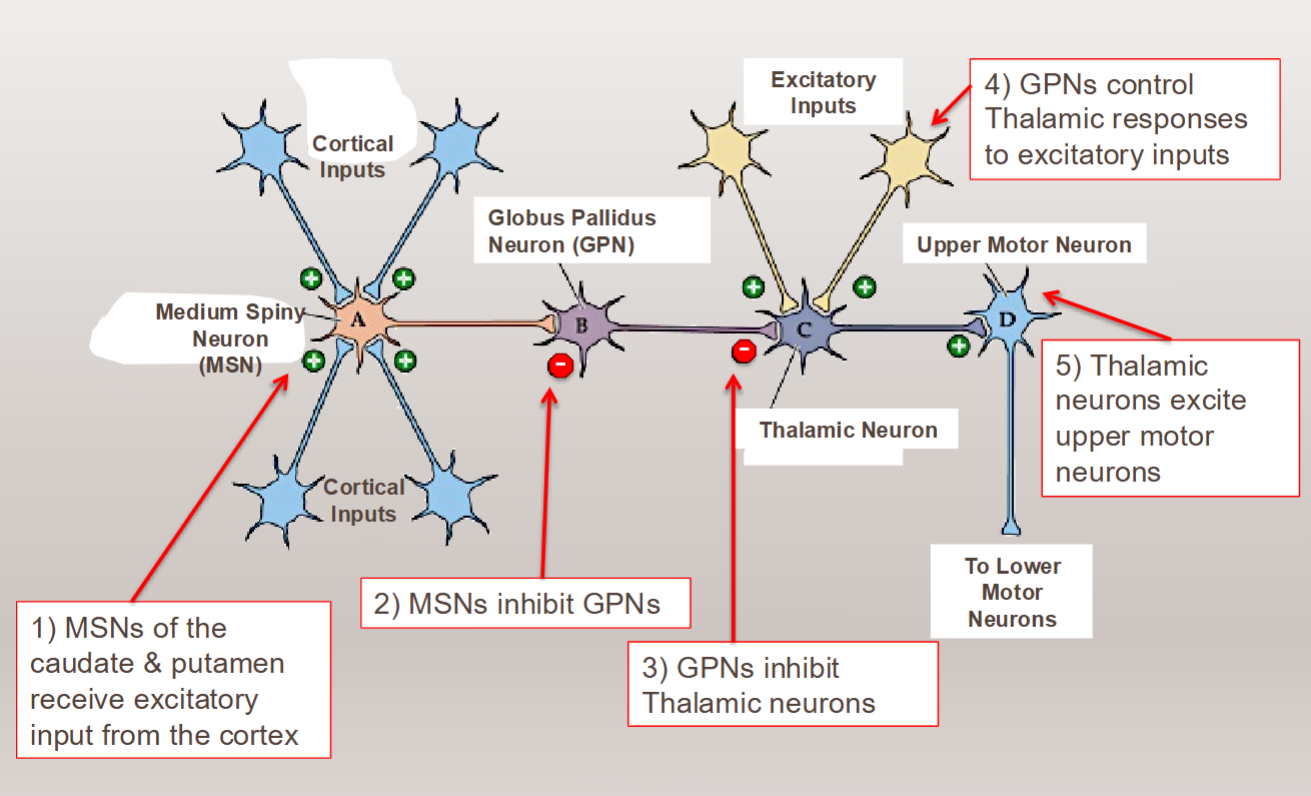
If there is no input from the cortex, there is no (or aberrant) movement because....
No Cortical inputs to excite the MSNs
Tonically Active GPN Inhibits Thalamic neuron
Inhibited thalamic neuron does not respond to incoming excitation and does not stimulate upper motor neurons – preventing unwanted movement.
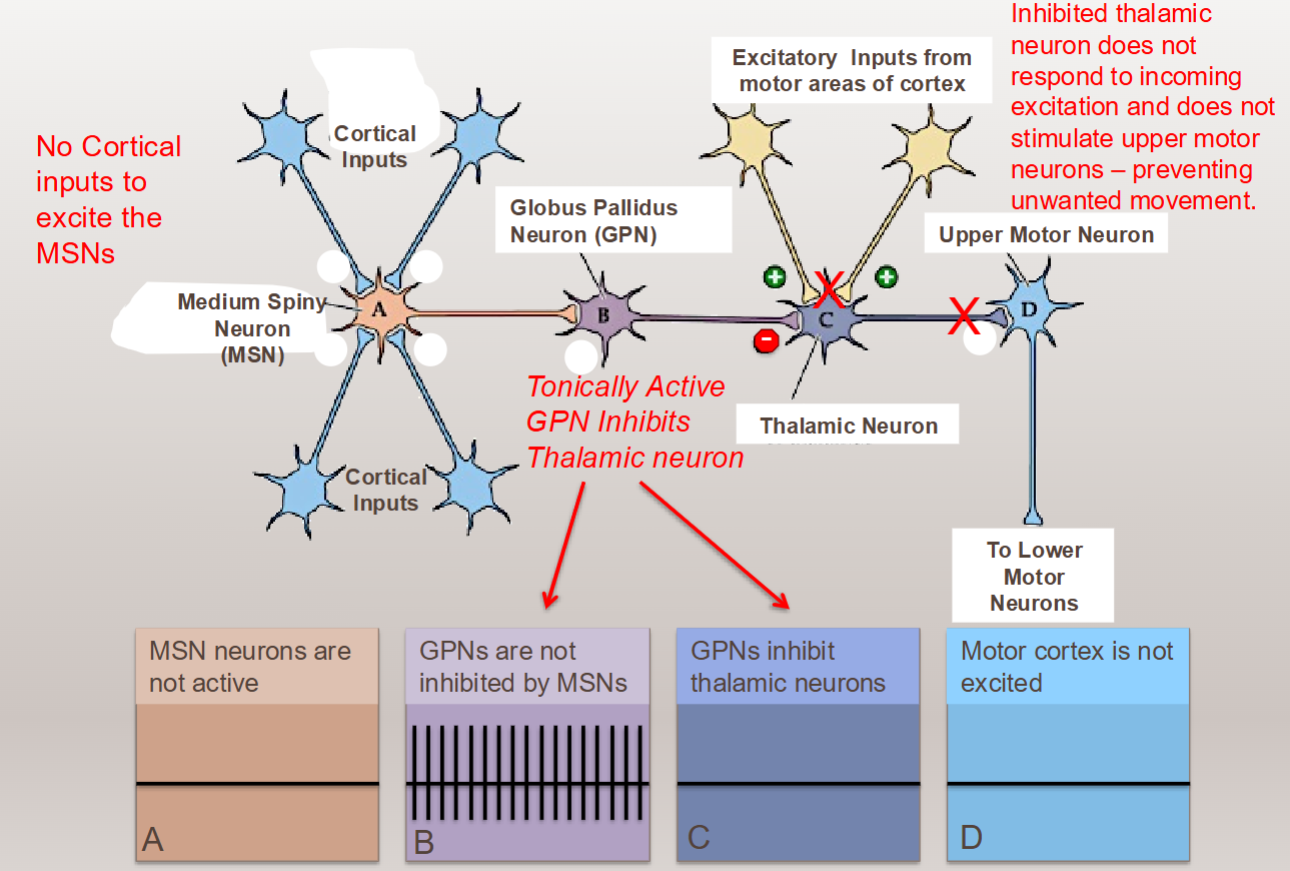
Cortical input excites the MSNs and there is correct movement because....
Cortical inputs excite the MSNs
MSNs inhibit GPNs and disinhibit thalamic neurons
Thalamic neurons can respond to inputs and drive the upper motor neurons
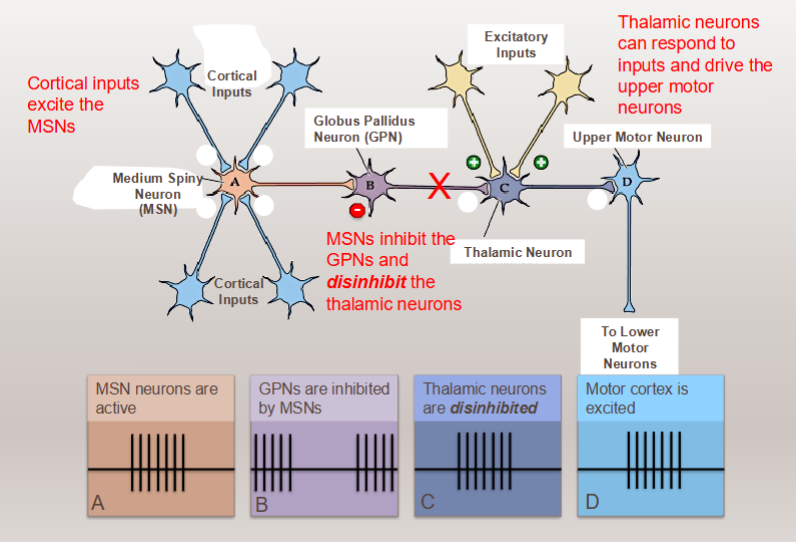
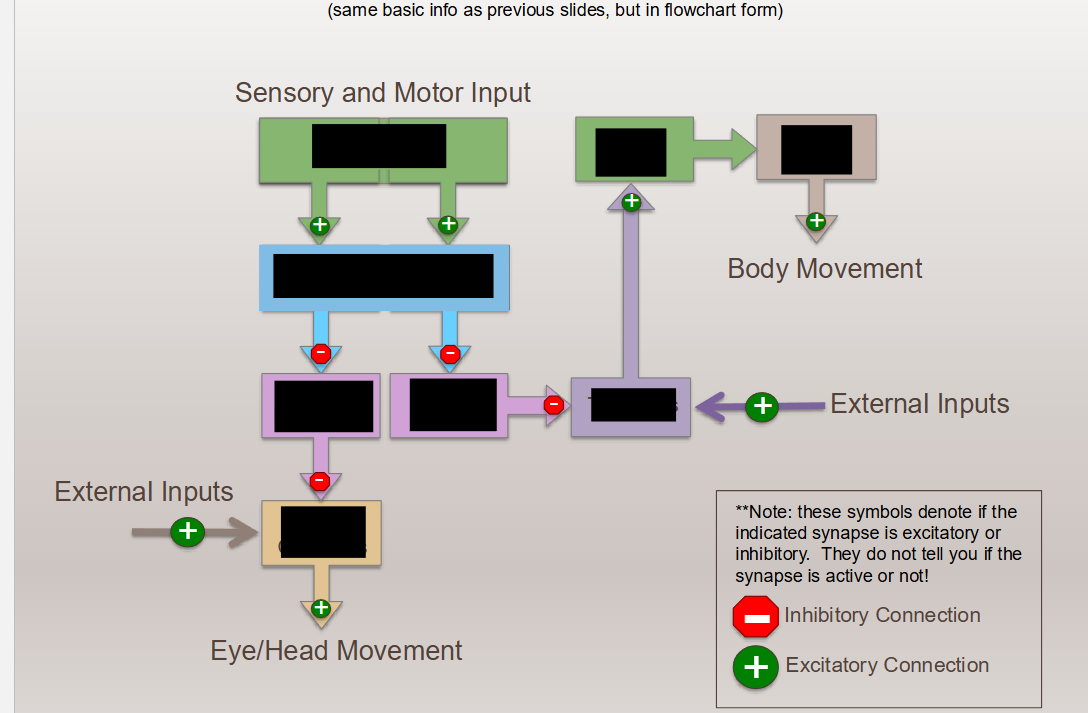
fill in this chart for the direct pathway
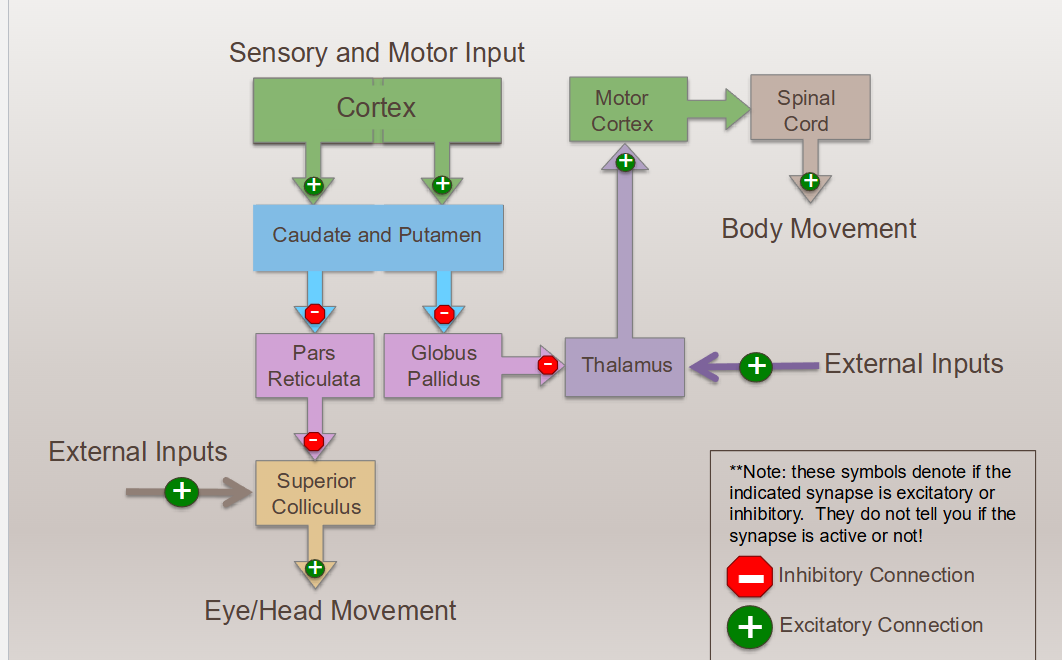
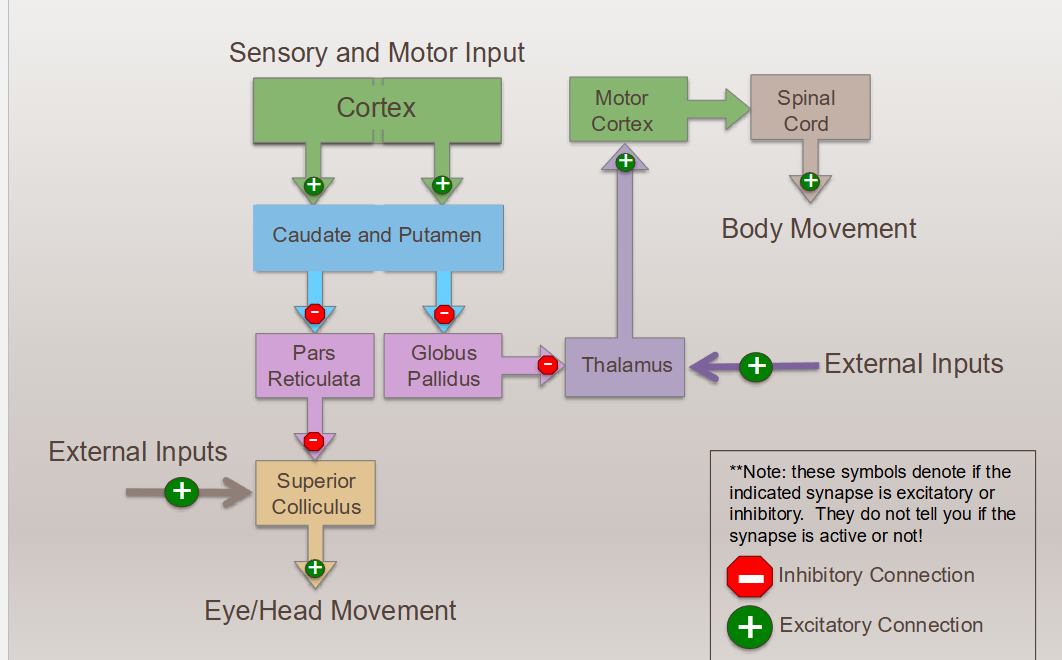
What happens when the direct pathway is at rest
Without cortical input to the basal ganglia, neurons in the Globus
Pallidus or Pars Reticulata tonically inhibit the thalamus and prevent movement
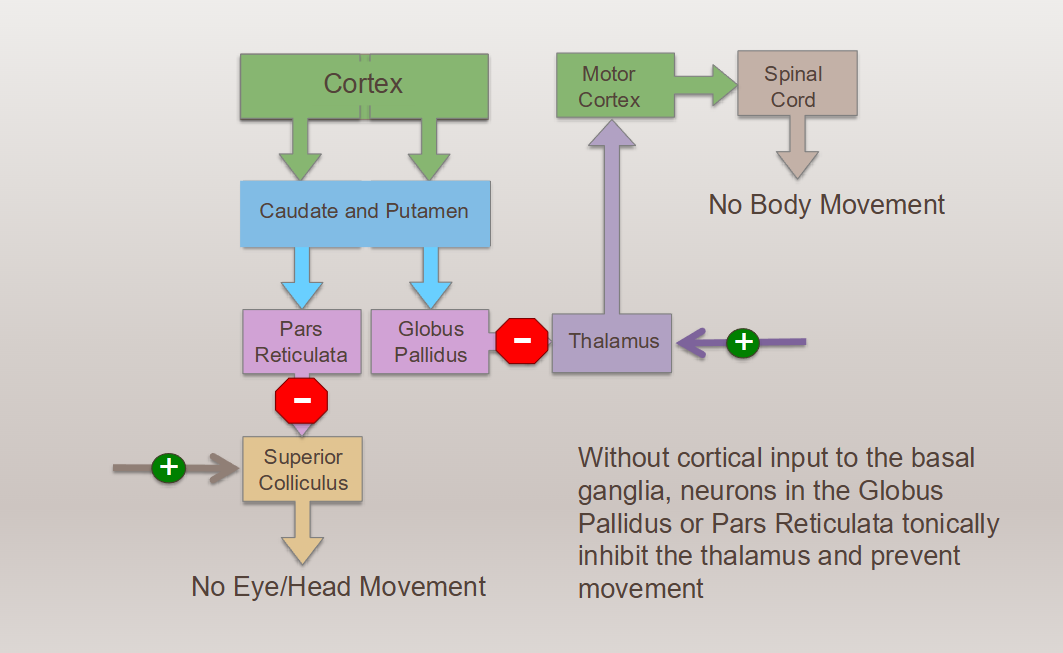
Disinhibition
___ input to the basal ganglia excites
___ in the ____ and ____ which
______ neurons in the _____ ______ or
_____ ________ and _____ the
_____ or ____ ____ to promote
movement
Cortical input to the basal ganglia excites
MSNs in the Caudate and Putamen which
inhibit neurons in the Globus Pallidus or
Pars Reticulata and disinhibit the
thalamus or superior colliculus to promote
movement
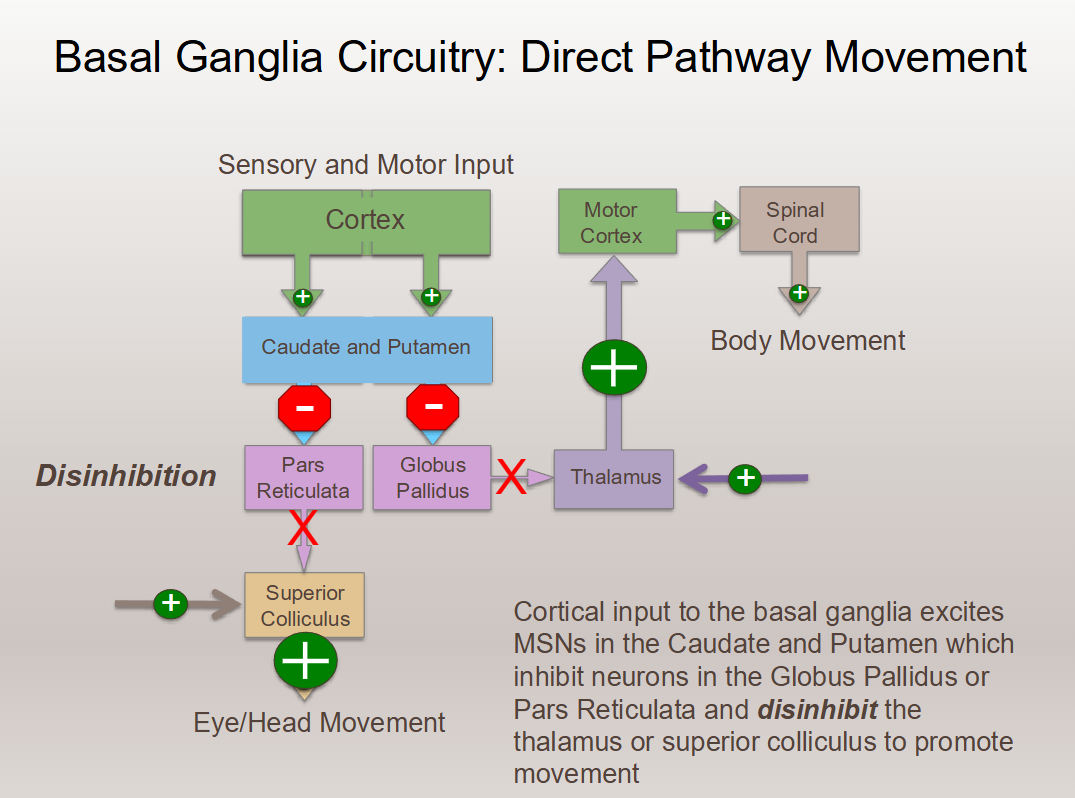
What are the main nuclei of he basal ganglia
Motor Nuclei
Caudate
Putamen
Globus Pallidus
Substantia Nigra Pars Reticulata
Modulatory Nuclei
Subthalamic Nucleus
Substantia Nigra
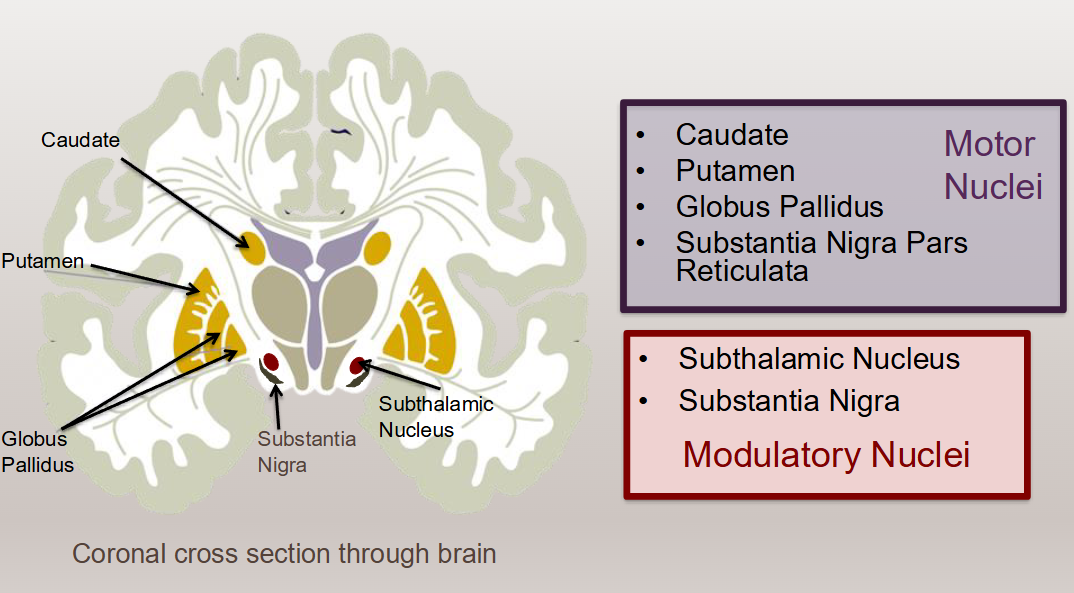
What pathway is the subthalamic nucleus responsible for
Hyper-Direct Pathway
• Receives excitation from cortex
• Role: Provide excitatory drive globus pallidus internal (GPI)
• Must be inhibited for movement
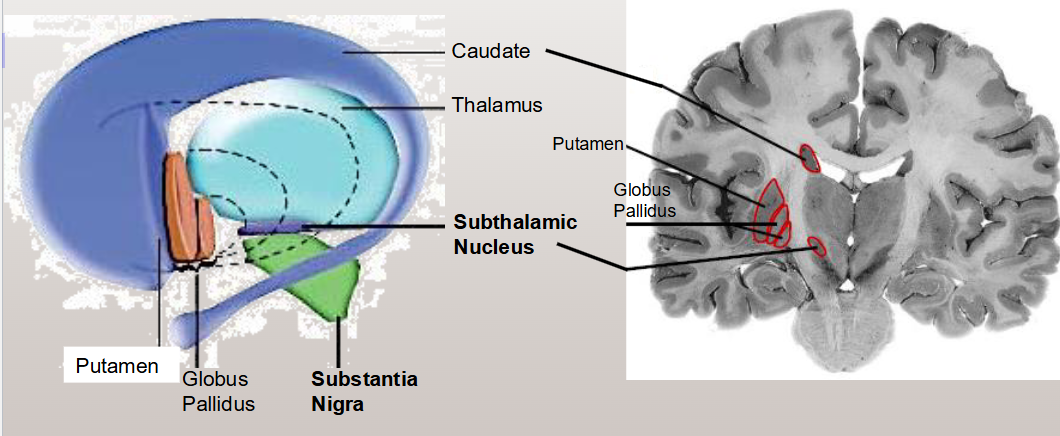
What are the three different pathways through the basal ganglia?
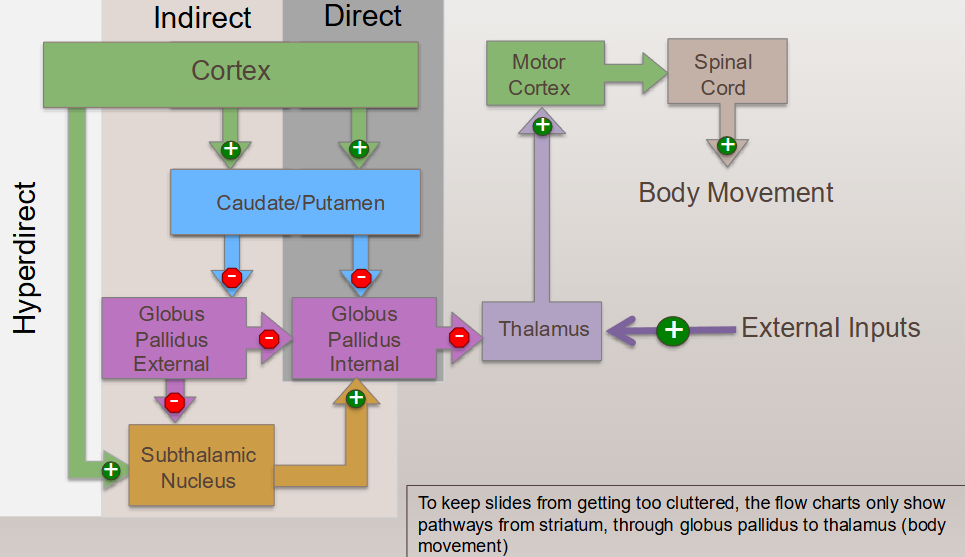
What do the different pathways allow for?
allow for flexibility required for smooth control of movement
What is the pathway for head and eye movement?
striatum → s.n. pars reticulata → superior colliculus
What is the hyperdirect pathway?
The hyperdirect pathway through the STN can counteract the direct pathway to modulate movement
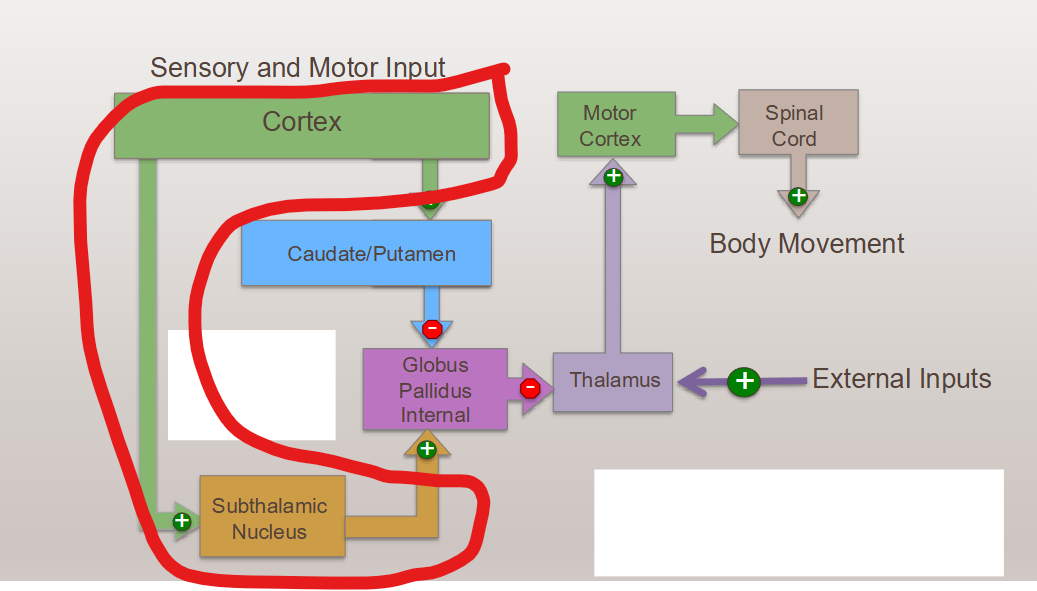
What is the hyperdirect pathway and how does it affect the direct pathway?
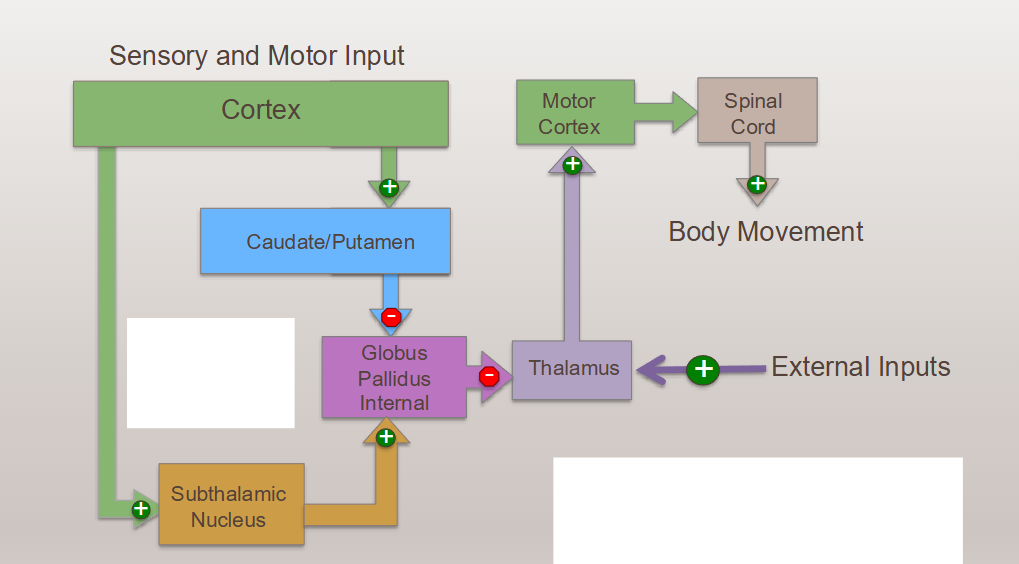
What is the indirect pathway and how does it affect the direct pathway?
The indirect pathway counteracts the direct
pathway to terminate movement or
suppress unwanted movements by
increasing the inhibitory influence of the
internal globus pallidus

What is the purpose of the substantia nigra?
• Receives excitation from corpus striatum
• Role: Provide dopaminergic input to the corpus striatum
• Excites the direct pathway, inhibits the indirect pathway
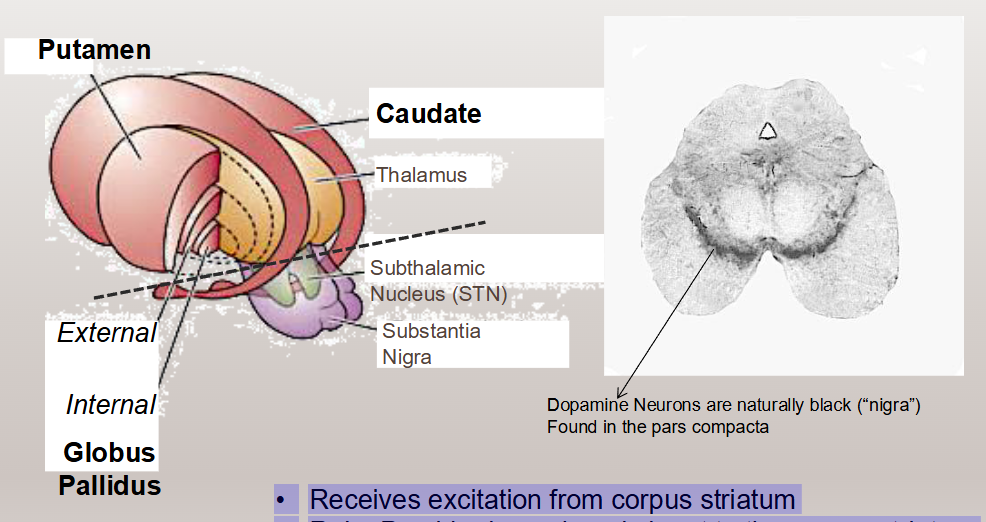
Dopamine normally _____ movement
How?
enhances
• The substantia nigra pars compacta
provides dopamine to the MSNs of the
corpus striatum (caudate/putamen)
• The dopamine increases the activity of
the direct pathway but suppresses the
indirect pathway
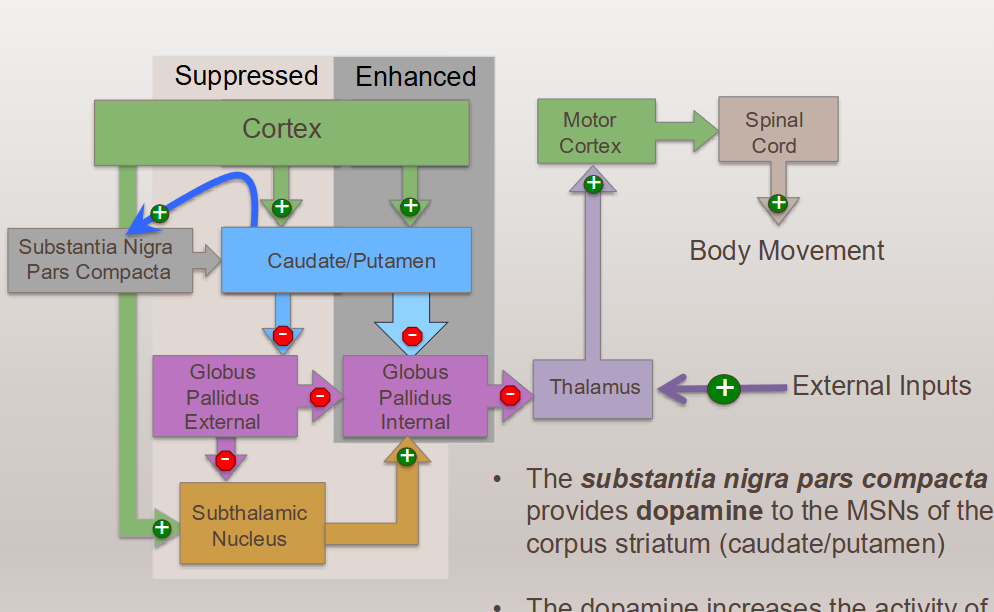
What is Parkinson’s disease
loss of dopamine neurons in substantia nigra
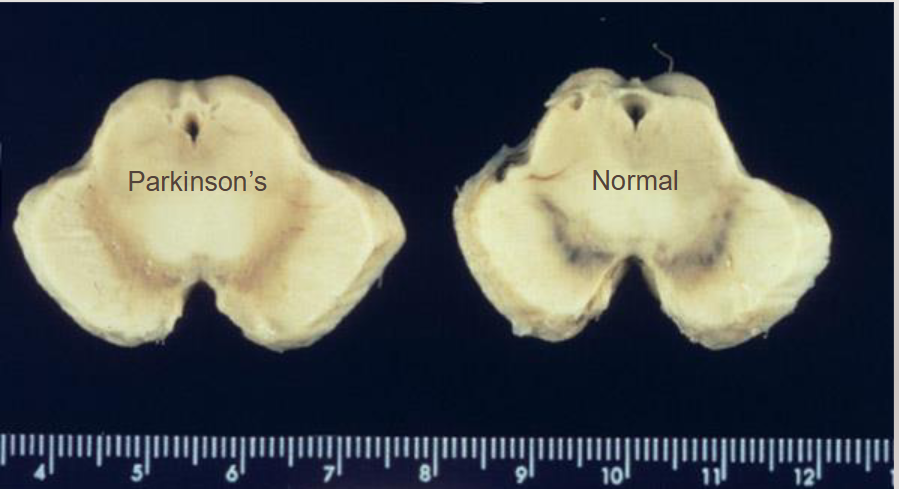
How does Parkinson’s affect the pathways?
• The loss of dopamine to the MSNs of
increases the activity of the indirect
pathway but suppresses the direct
pathway
• Makes movement hard to start and stop
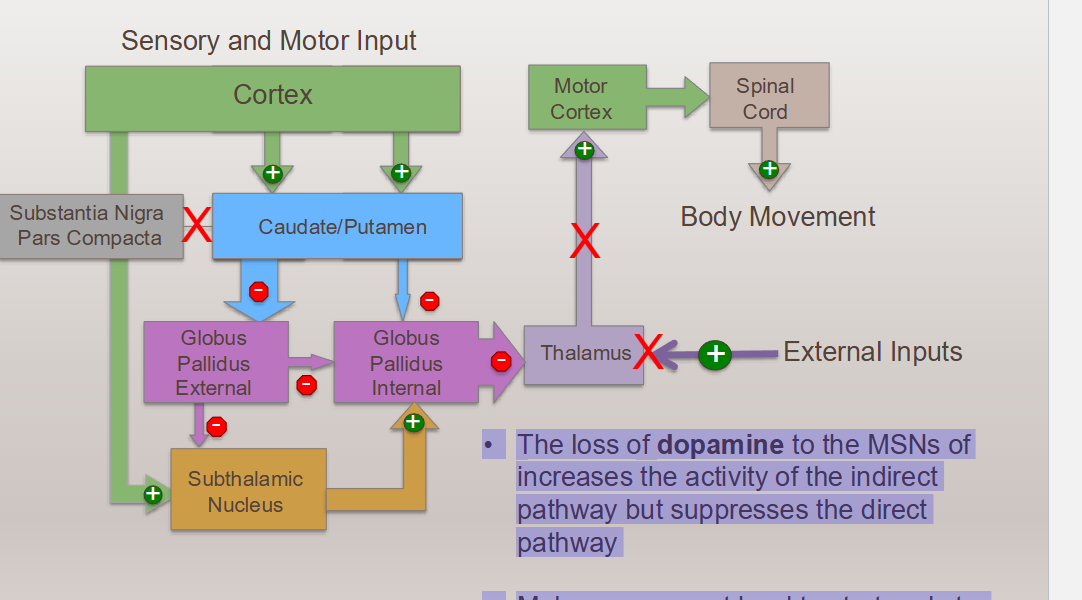
What is Huntington’s Dsease?
Atrophy of cerebral nerve tissue and BG
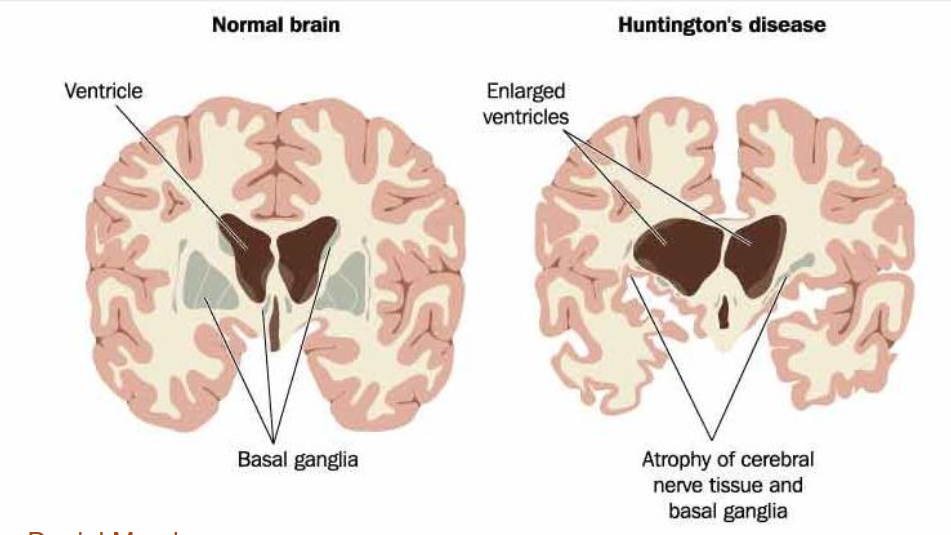
How does Huntingtons Diseases affect the basal ganglia pathways
Increased Disinhibition
• The connection between the caudate and the GP-External is degenerated
• Increased inhibition of the GP internal
• To much ballistic movement
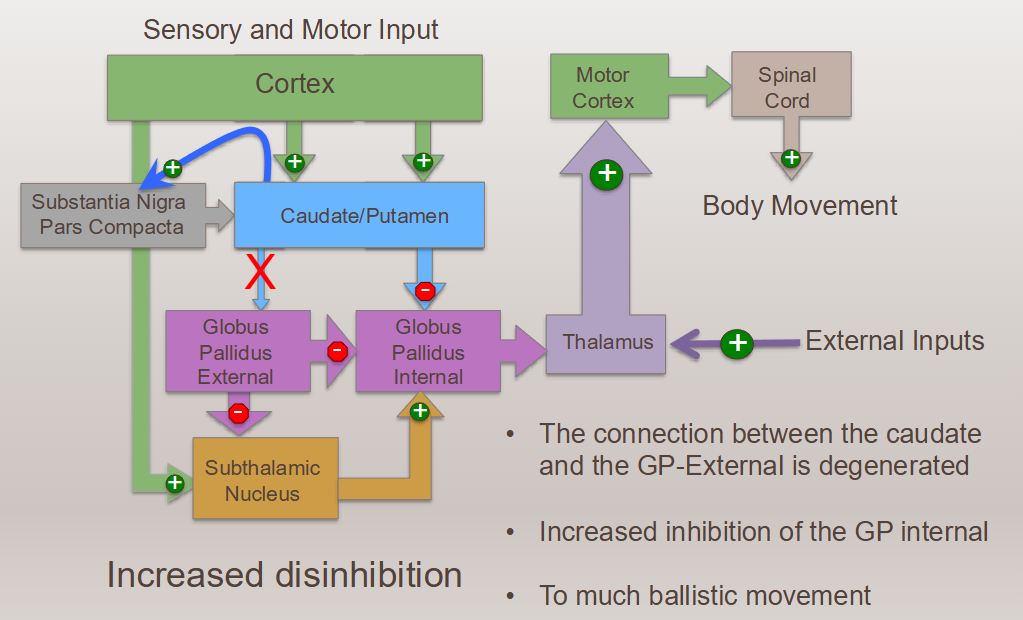
What are the different forms of input to the cerebellum?
• Cortex- via the pons
(Movement information)
• Spinal cord (Sensory
input)
• Vestibular Nuclei
(Sensory input)
• Olive (Sensory and
modulatory input)
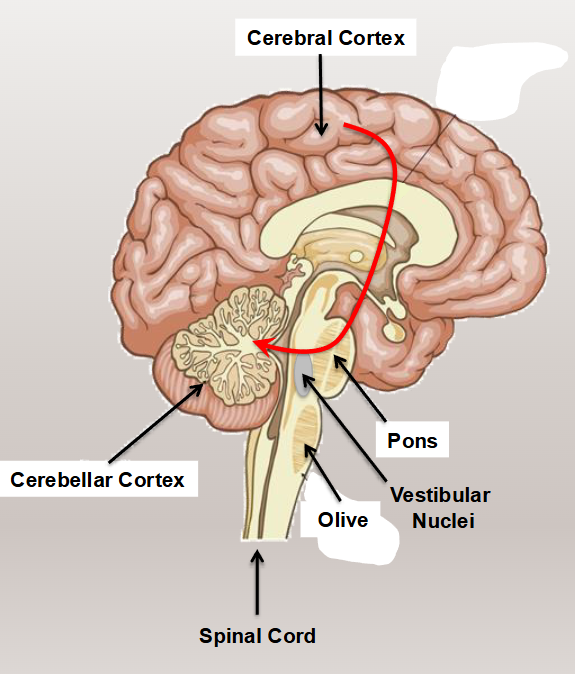
What are the different parts of the cerebellar cortex?
Cerebrocerebellum
Spinocerebellum
Vestbulocerebellum
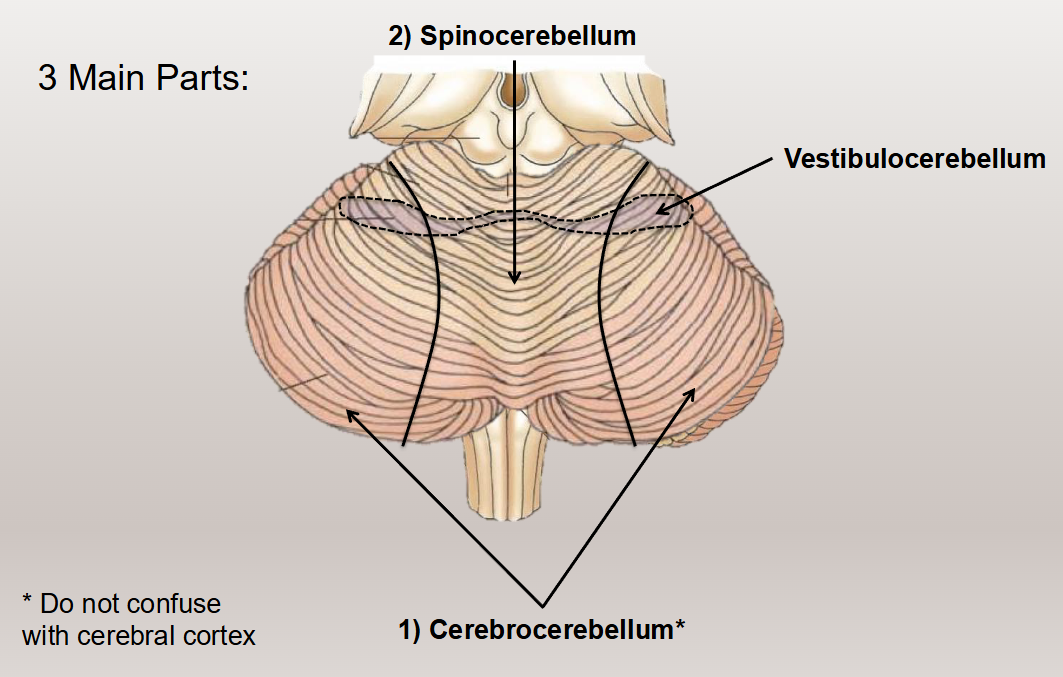
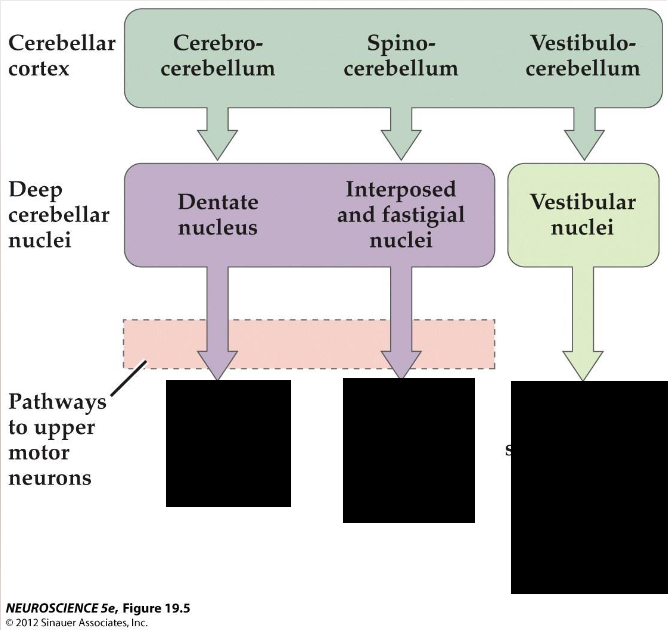
Fill in this chart
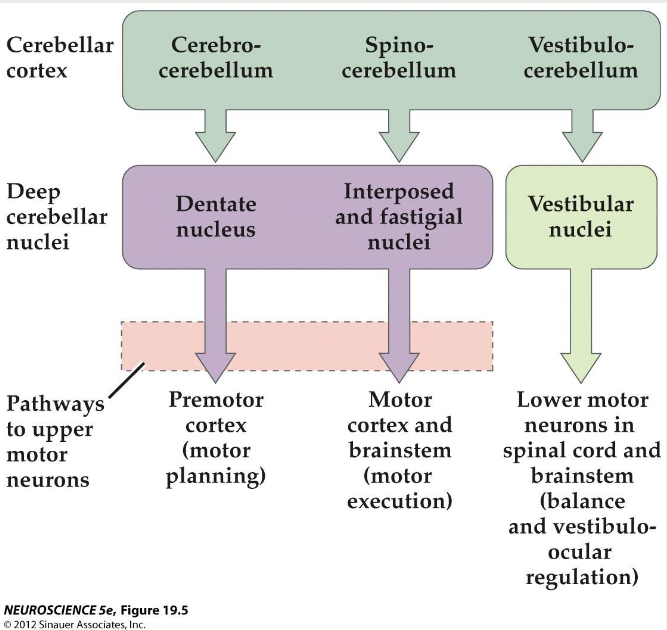
What is the function of the cerebrocerebellum
• Input from cerebral cortex
• Skilled movements
• Planning and execution of movement sequences in time and space
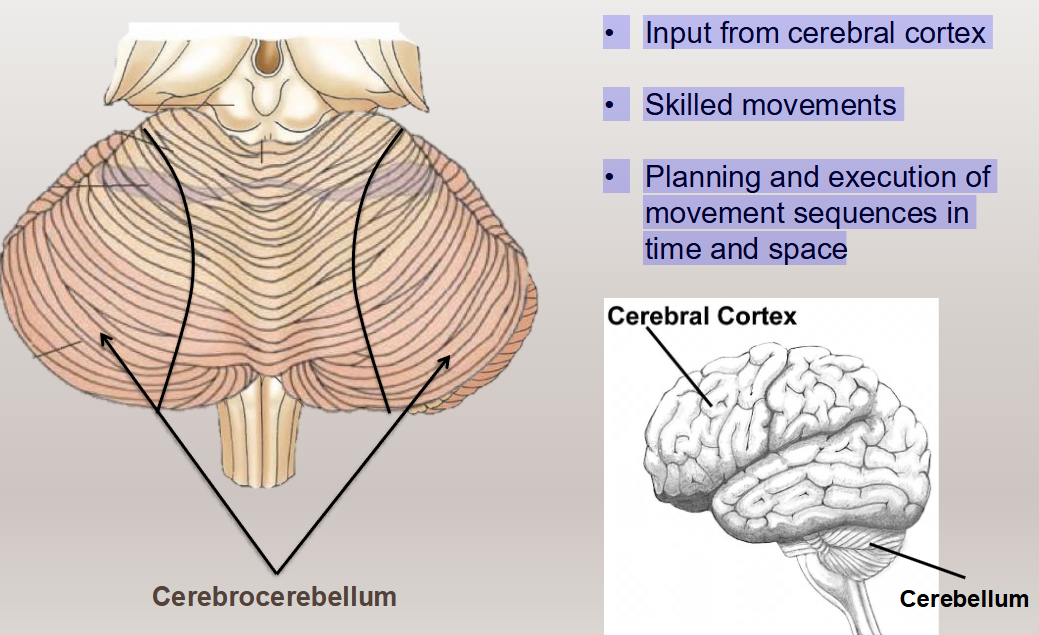
What happens when there is damage to the cerebro-cerebellar pathway
one example
Damage can cause dysmetria: errors in smoothness and direction
of targeting movements
• Patients tend to over- or undershoot objects
• The closer the movement gets to the target, the more irregular the
movement (intention
tremor)
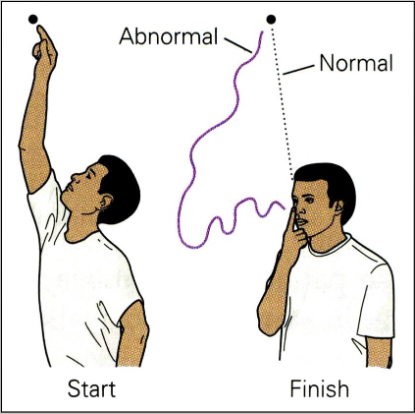
What is the purpose of the spinocerebellum
• Input from the spinal cord
➢ Sensory
• Has somatotopic maps
• Two zones:
➢ Median
➢ Paramedian
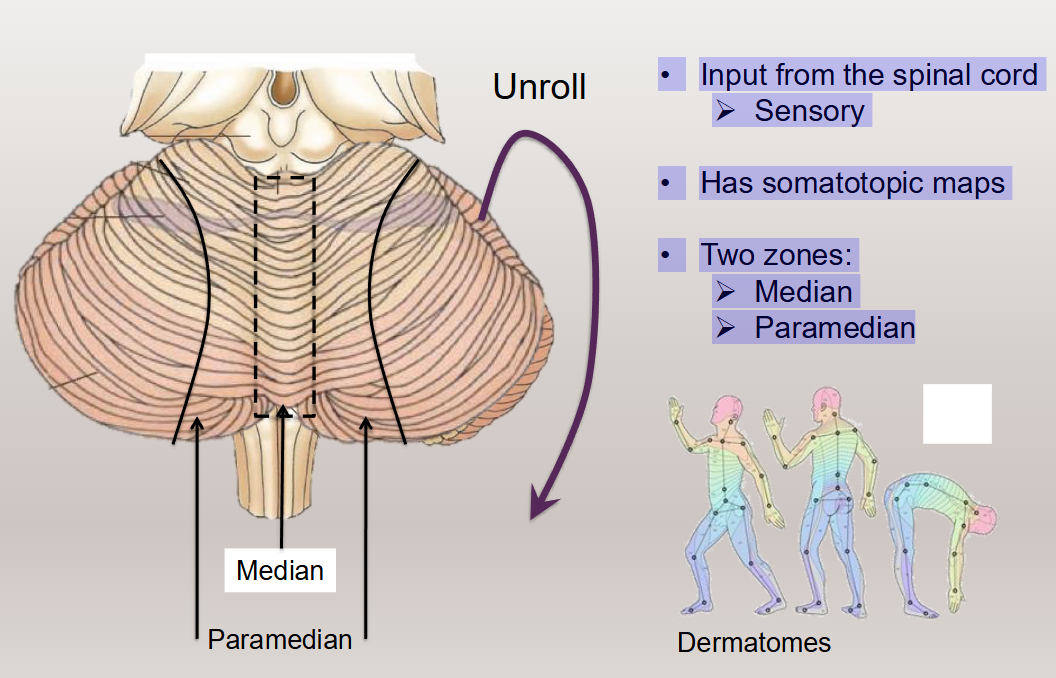
What is the purpose of the vestibulocerebellum
• Input from Vestibular Nuclei
• Coordinate Posture, Balance
• Coordinate eye-body movements- i.e. Vestibular ocular reflex (VOR)
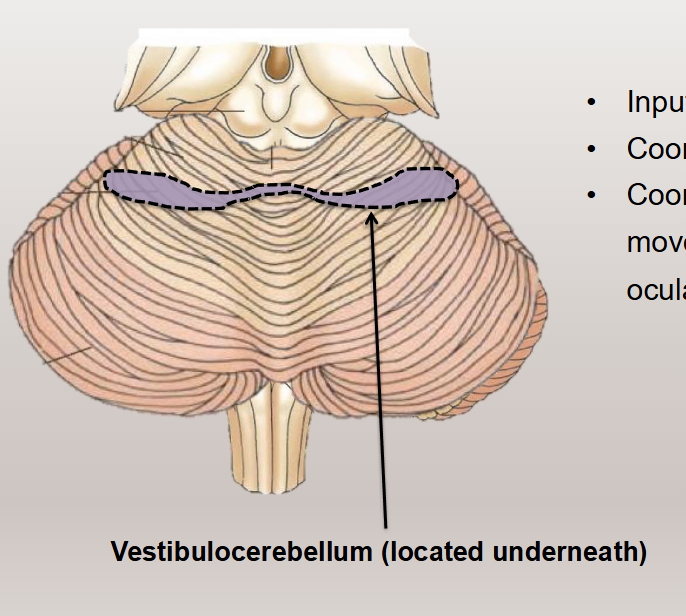
What are some characteristics of cerebellar nuclei?
• Receive ____ input from the ____ _____
• Sole source of ____ from the cerebellum
• Project to the _____ (which projects to motor
cortex)
• Project to the ____ ____ ____ _____
• Receive inhibitory input from the cerebellar cortex
• Sole source of output from the cerebellum
• Project to the thalamus (which projects to motor
cortex)
• Project to the brainstem upper motor neurons

What are the nuclei involved in the motor planning pathway and the motor execution pathways?
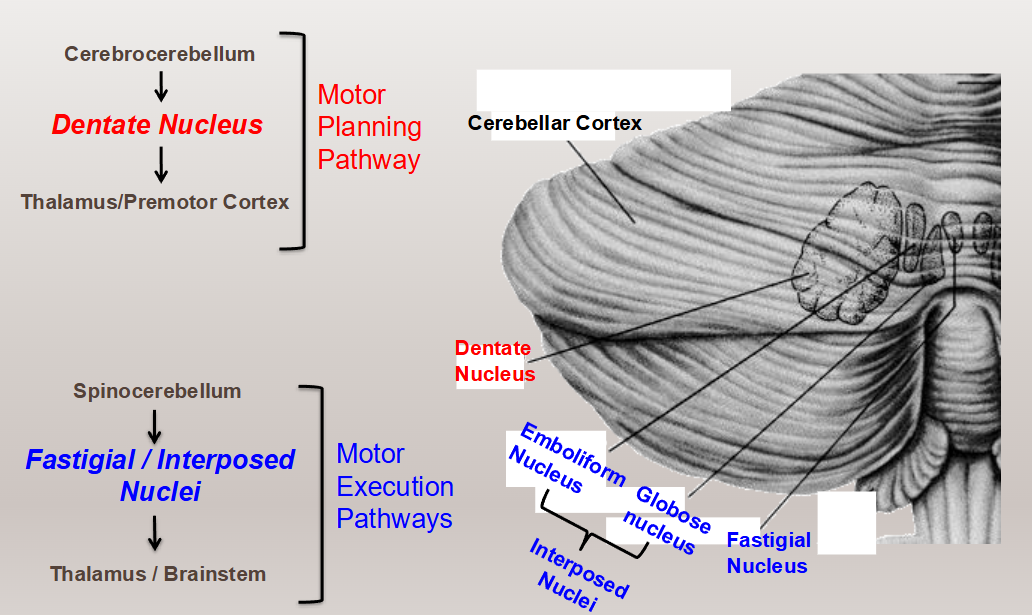
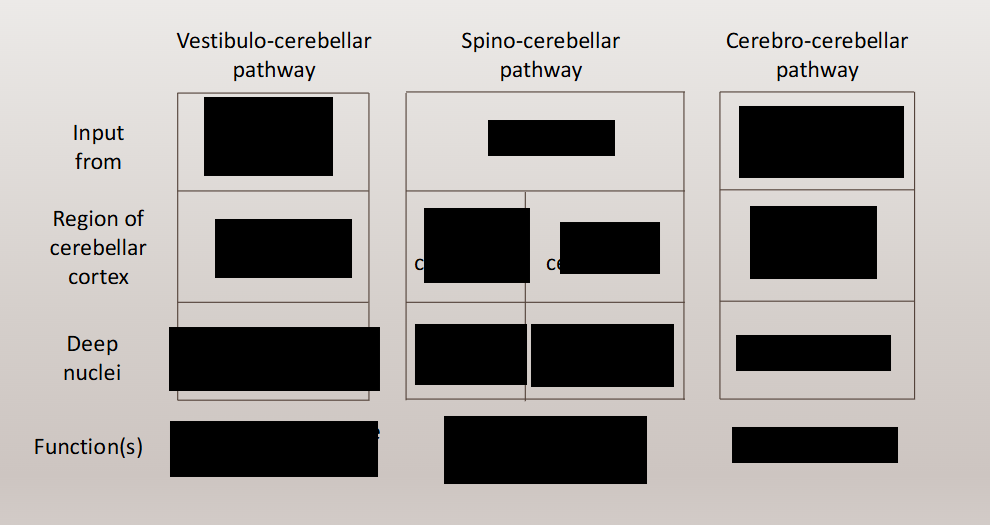
Fill in Chart
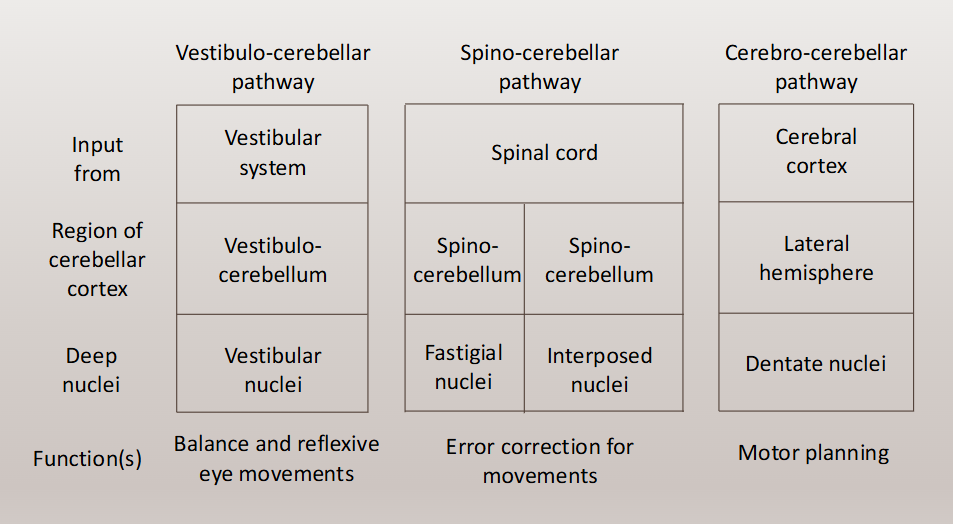
How does information cross over from cortex to cerebellum? What is the purpose
• Coordinates descending input from the ____ and ascending input from the ___ ____ and _____.
• In the cortex _____ muscle movements are represented in the
____ hemisphere
• At the spinal cord the muscle movements are driven by ____
neurons
• The cerebellum has an ______ representation of muscle movement (like the___ ___)
• Coordinates descending input from the cortex and ascending input from the spinal cord and brainstem.
• In the cortex ipsilateral muscle movements are represented in the
contralateral hemisphere
• At the spinal cord the muscle movements are driven by ipsilateral
neurons
• The cerebellum has an ipsilateral representation of muscle movement (like the spinal cord)
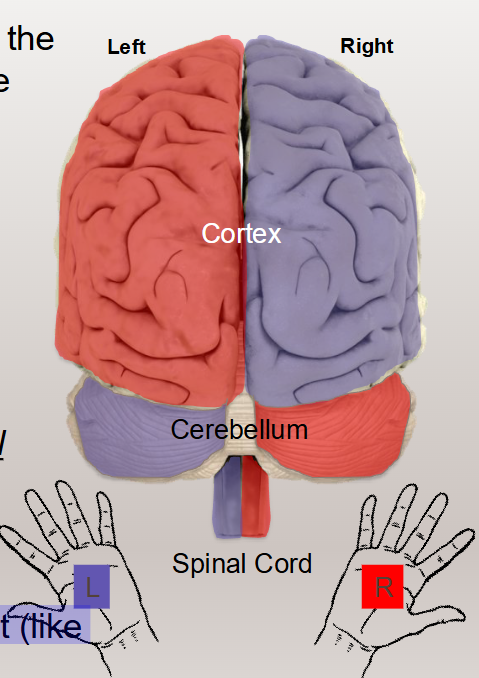
Cerebellum can allow for ___ ____ ____ in motor skill
very rapid changes
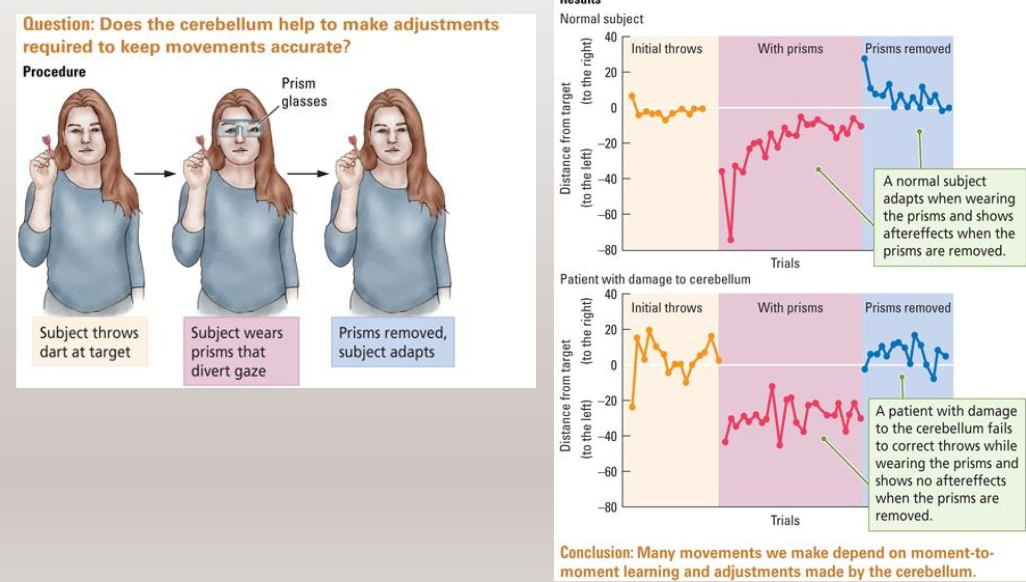
What is ataxia and what is its effects?
• Ataxia - is a neurological
disorder consisting of lack of
_____ ______ of ____ ____
• Many causes: ____ ____one of the primary
causes
– Could be due to
______ factors
(alcohol, trauma)
– Also caused by _____
disorders (e.g.
spinocerebellar ataxia)
• Ataxia - is a neurological
disorder consisting of lack of
voluntary coordination of muscle
movements.
• Many causes: cerebellar
dysfunction one of the primary
causes
– Could be due to
environmental factors
(alcohol, trauma)
– Also caused by genetic
disorders (e.g.
spinocerebellar ataxia)
– Mouse model of ataxia
– patient with cerebellar ataxia
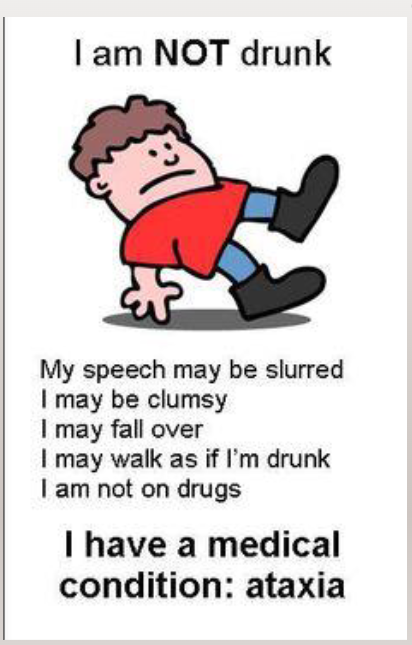
Cerebellum is a target of ____
Short term effects of alcohol
– Lack of _____
– Unsteady ____
– ____ speech
Long term effects??
– Damage to _____ portion of ____ _____ affects movement in ____ ____
• ____ and ______ gait
• ____ impairment of arm or hand movements
• ____ disruption of speech
Short term effects of alcohol
– Lack of coordination
– Unsteady gait
– Slurred speech
• Long term effects??
– Damage to anterior portion of cerebellar cortex (anterior vermis in fig) affects movement in lower limbs
• Wide and staggering gait
• Little impairment of arm or hand movements
• No disruption of speech
